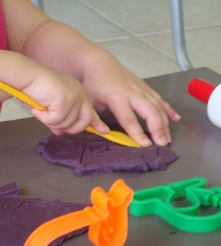They are often for communication purposes, both functional and expressive, e.g. writing or typing text, manipulating tools or creating works of art.
Between the ages of three and five children usually make rapid progress in developing fine motor skills and manual dexterity. However, these skills still require time, patience and plenty of practice. Fine motor skills include:
- Ocular motor control – the ability of the eyes to follow and focus on an object in the field of vision as required.
- Hand-eye co-ordination – the ability to execute activities with the hands, guided by the eyes requiring accuracy in placement, direction, and spatial awareness.
- Foot-eye co-ordination – the ability to execute actions with the feet, guided by the eyes.
- Manual dexterity –the ability to accurately manipulate the hands and fingers for neat handwriting, drawing, typing skills etc.
- Stereognosis – the ability to recognise unseen objects using the sense of touch.
- Tactile perception – the interpretation of information transmitted via the fingertips to the brain.
In order for children to develop good fine motor skills, there are also other supporting skills that need to be well-developed. For instance children need to have strength and dexterity in their hands and fingers before being required to hold a pencil correctly and begin writing activities. This can help avoid incorrect pencil grips.
Developing Fine Motor Skills
Remember, that each individual has their own unique strengths and weaknesses. I believe that in life, we all need to learn to improve our weak areas to an acceptable standard, compensate for them where necessary while focusing on, developing and enjoying our strengths and talents.
No one is good at everything. The object of these stimulating activities, is to help your child develop each area to her unique potential, not to over-stimulate or try and develop super-babies!
The following are suggestions of activities you can do with your child to develop fine motor skills. They are aimed at 3-5 year olds, but since this is a wide range, you should adapt them according to your child's proficiency.

1.2 Tearing paper into fine strips – use them for collage or crumple them into balls.
1.3 Screwing up whole pieces of newspaper in one hand at a time to develop strength.
1.4 Threading beads or macaroni onto string.
1.5 Lacing activities.
1.6 Cutting out with scissors, using the correct grip.
1.7 Manipulating clothes pegs to pick up small objects.
1.8 Performing fingerplays.
1.9 Preschool Sewing Activities are an excellent way to develop fine motor skills.
2.1 Finger painting or manipulating other liquids with the fingers and hands e.g. slushy mud, tomato sauce (ketchup) on a plate
2.2 Picking up small objects with the fingers, like pegboard pegs, rice grains etc.
3.1 Wheelbarrow walking, crab walking, hanging on playground apparatus to develop strength of the upper body.
3.2 Working on a vertical surface such as a blackboard or easel which requires the wrist to be bent back is good for developing fine motor skills.
An upright surface encourages a stable wrist position to develop good thumb movements, strengthen fine motor muscles and encourages the use of both the arm and shoulder muscles.
If you don’t have a blackboard or easel, tape some newsprint to the wall and have your child draw and scribble on that.
Let her draw large circles, using each hand respectively. Let her draw lines right across the sheet from top to bottom, diagonally and horizontally in both directions, using each hand respectively.


No comments:
Post a Comment